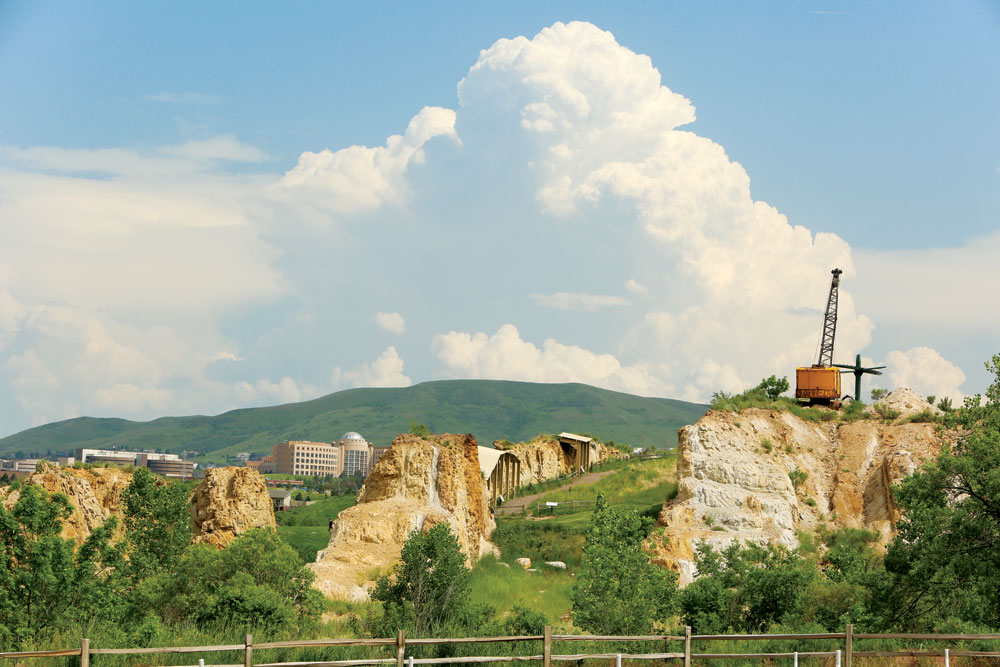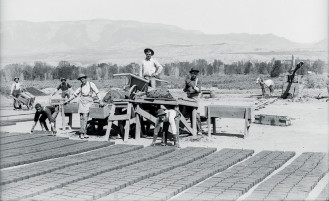 Ever notice those fin-like walls of sandstone along the Front Range? They parallel the mountain foothills like our very own Great Wall of China. These fins are hallmarks of one of Colorado’s most distinctive locally grown industries—clay mining for bricks, ceramics, and china.
Ever notice those fin-like walls of sandstone along the Front Range? They parallel the mountain foothills like our very own Great Wall of China. These fins are hallmarks of one of Colorado’s most distinctive locally grown industries—clay mining for bricks, ceramics, and china.
The clay-mining industry has existed since we were still part of the Kansas Territory, and not only fuels our local economy to the tune of 100 million bucks per year, but has impacts locally and nationwide. It even saved a brewery from bankruptcy.
Its story begins in mud. And not just any old mud, but ancient mud dominated by clay minerals that have special chemical and physical qualities. These clays settled out of the water in stagnant lakes and swamps that covered much of Colorado 65 to 100 million years ago, when dinosaurs roamed the landscape. Periodically, river sands emptied into these bays and swamps. After burial, these sediments hardened into claystone and sandstone.

A giant steam shovel sits atop the sandstone fins in the now-defunct Rockwell Clay Mine. After mining most of the easy-to-get clay from between the sandstone rock, the mine closed and was repurposed into the Fossil Trace Golf Club of Golden.
Millions of years later, the Rocky Mountains began to rise, tilting these sedimentary rocks like the upturned edge of a taco shell. The strata were now vertical—so clearly undressed by nature that early settlers could see that they held vast seams of sandstone, coal, and slippery claystone. These deposits were fortuitously located near areas where miners gathered supplies en route to the Rockies in search of gold and silver.
Residents of the newly formed hamlets of Golden, Denver, and Cañon City began to mine these clays to make brick for buildings. Deep trenches were excavated in between the uplifted sandstones, where men and machines dug long grooves in the earth to remove the clays.

Historically, brickmakers put newly molded bricks in the sun prior to firing them in the kiln. This process helped the wet bricks stiffen so that they could be handled without risking deforming the bricks.
The great Denver fire of 1863 kicked the clay mining business into high gear. That year, much of the city burned to the ground, owing to closely spaced wooden buildings and a poorly equipped fire department. Legislators enacted an ordinance requiring all buildings to be built with brick or stone. Brick was faster, cheaper, and more uniform than stone, and for the next century, nearly every home was constructed of brick.
By 1900, there were more than 200 brick-making factories in Colorado. The clay here was so exceptional that vast numbers of bricks were exported, even lining the walls of buildings at Harvard University. Locally-made bricks were used to build Larimer Square, much of the Auraria campus, and later, Coors Field.
What makes these ancient clays such ideal building materials? Our clays include rare ones that are high in silica or are high in aluminum compounds. When baked at about twice the maximum temperature of your oven, these mineral ingredients melt into a crystalline mass, which helps glue the brick together. Depending on the composition of the clays that are used, and the temperature at which they are baked, one can produce red bricks, brown bricks, or even ones with distinctive purple and black specks.
World War I was the pivot point for Colorado’s special clays, especially those like kaolinite, which could be used to make white porcelain and other ceramics. Prior to the war, most laboratory and industrial ceramics, not to mention domestic bakeware, were imported from European countries such as Germany. Colorado clays helped fill the gap when the Great War began, and the Herold China and Pottery Company began to flourish. Backed by, and later owned by Adolph Coors, this company grew into one of the world’s largest porcelain and ceramic businesses. Indeed, during Prohibition (from 1920–1933), sales of clay-based products kept the Coors Company afloat, as beer sales were illegal. Coors’ ceramics company, CoorsTek, still flourishes today.
Today, four brickmakers remain in Colorado. And they thrive—over 60 percent of their products are exported out of state. Their ingredients? They’re still sourced right here—in your backyard. Their clay quarries are active and can be seen as you drive across Rocky Flats north of Golden or near Lockheed-Martin south of the Denver metro area.
For an up-close look at Colorado clay, take a walk along the Front Range. Hike Dinosaur Ridge, amble down the Triceratops Trail, or play a round at the Fossil Trace Golf Club. Here the easy-to-reach clays have been mostly mined out, leaving behind the fins of river-borne sand that were deposited above and below them. The footprints of dinosaurs that walked in the clay-rich muds are still there, like sentinels guarding a deep reserve of some of the best clay in the world.
James Hagadorn, Ph.D., is a scientist at the Denver Museum of Nature & Science. Suggestions and comments are welcome at jwhagadorn@dmns.org.




0 Comments